Reader Friendly: A Guide to Tie-In Comics Part 1: DC Comics
- Jonathan Eilbeck
- Apr 29, 2018
- 19 min read
Disclaimer: I do not claim any ownership to any of the images used. They are the property of their respective owners.
So one of the hallmarks of comic books are event comics. They're basically summer blockbusters that come out monthly. Now what event comics bring to the table are several things. Massive crossover storylines, huge impacts on the universe (until the next event), new comics spinning off from said events, but also tie-ins.
Tie-ins are when a single or more issues of an ongoing comic series where they take a break from their respective storylines and do a story related to the event that's currently happening. These are mostly done to help boost sales on certain series and also gain interest into an event. So I'm going to talk about certain tie-in issues that I've read, because I waited on the trade paperback of events.
Forever Evil's Villains Month

So around 2013-2014 during the New 52 era of DC Comics, they had their first big event Forever Evil. The for this is event is that the Crime Syndicate, an evil version of the Justice League, has taken over the world. Throughout the month of October DC dedicated an entire month to their villains, by letting them takeover the book of their respective hero. Each book gave us a new origin and a glimpse at what the world was like under the Crime Syndicate's control.
Joker: Batman
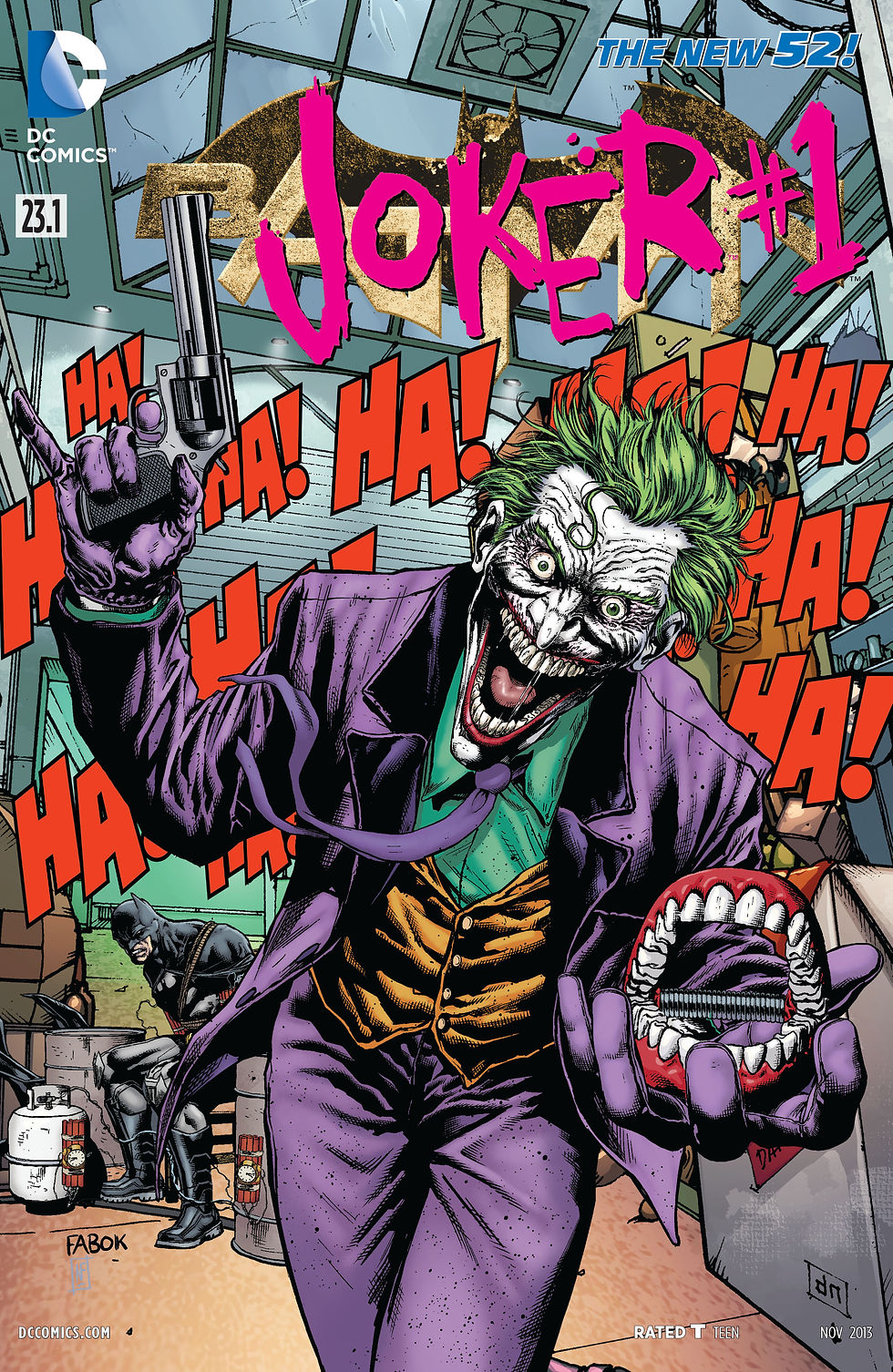
So during this period in the Bat books, the Joker was presumed dead after the events of Scott Snyder's storyline Death of the Family. So this one-shot doesn't tie-in to the Forever Evil event. The issue is okay. Written by Andy Kubert and drawn by Andy Clarke. This story involves Joker adopting a baby gorilla and raising it into a literal gorilla soldier. The story does give the Joker an origin, but then again its multiple choice. Art looks nice though.
Cyborg Superman: Action Comics

This is an interesting one. See in the original pre-Flashpoint continuity Cyborg Superman was Hank Henshaw, a scientist who went into space, but after an disaster he became Cyborg Superman. A twist version of the Man of Steel, with actual steel. In the New 52 it's someone else. Written by Michael Alan Nelson and with art by Mike Hawthorne. This one-shot, set after Krypton's destruction bas Brainiac discover Argo City, the home of Supergirl which was saved by a dome, and Zor-El, Supergirl's father and Superman's uncle. Brainiac turns Zor-El into his herald, the Cyborg Superman, a name that doesn't make sense because Superman appeared years later so try and work that out.
The story itself is great, alternating between the Cyborg Superman massacring the inhabitants of an alien world and Zor-El's downfall. Between his falling out with his brother Jor-El over ideas to save Krypton to his loss over to save just one city. Very compelling stuff here.
Deadshot: Justice League of America

So at the time there were three Justice League books, the main Justice League, Justice League Dark, the magical team with magical heroes and the one I was reading Justice League of America. A League run by government with Amanda Waller looking over them. Now Deadshot wasn't an enemy of the team, they only had one enemy, the Secret Society, but they needed a way to lead into the Suicide Squad tie-ins. The book does give Deadshot an origin. That's all I have to say on this really. Killer Frost: Justice League of America

So, this is interesting. This issue was about Caitlin Snow, who is known for her appearance in the Flash TV show. Well before the New 52 there were two other Killer Frosts, Crystal Frost and Louise Lincoln. This new Killer Frost and origin is a pretty good story and origin. Her origin is different from the TV show, which is funny because the writer of this comic Sterling Gates also writes the Flash TV show. Caitlin Snow was a very curious and optimistic person with a passion in science. She was a cryogenics expert who was sent into to replace Louise Lincoln at a research base. Lincoln was murdered by the other scientists who work for H.I.V.E. and put her in a science machine which gives her ice powers. The rest of the comic s her lamenting the fact that anything she touches will die and also how she met Firestorm, because she was originally a Firestorm villain and how he's a cure for her ice problems. But then we see her motivation (and also lead in to the ARGUS tie-in miniseries at the time because Gates was writing this and that) wanting revenge against the Crime Syndicate for killing Firestorm (Firestorm was a League member.) This is a great origin for a legacy character.
Clayface: Batman: The Dark Knight

Now this is a fun shaggy dog story written by John Layman, the man who was writing Detective Comics at the time. This doesn't have a major connection to the main Forever Evil storyline other than the setting. The story is just Clayface trying to make it big, tries to attack the resistance cell. Turns out to be a sting operation for heroes to be captured. End. Fun story. One in done. Check it out. Or not. Ocean-Master: Aquaman
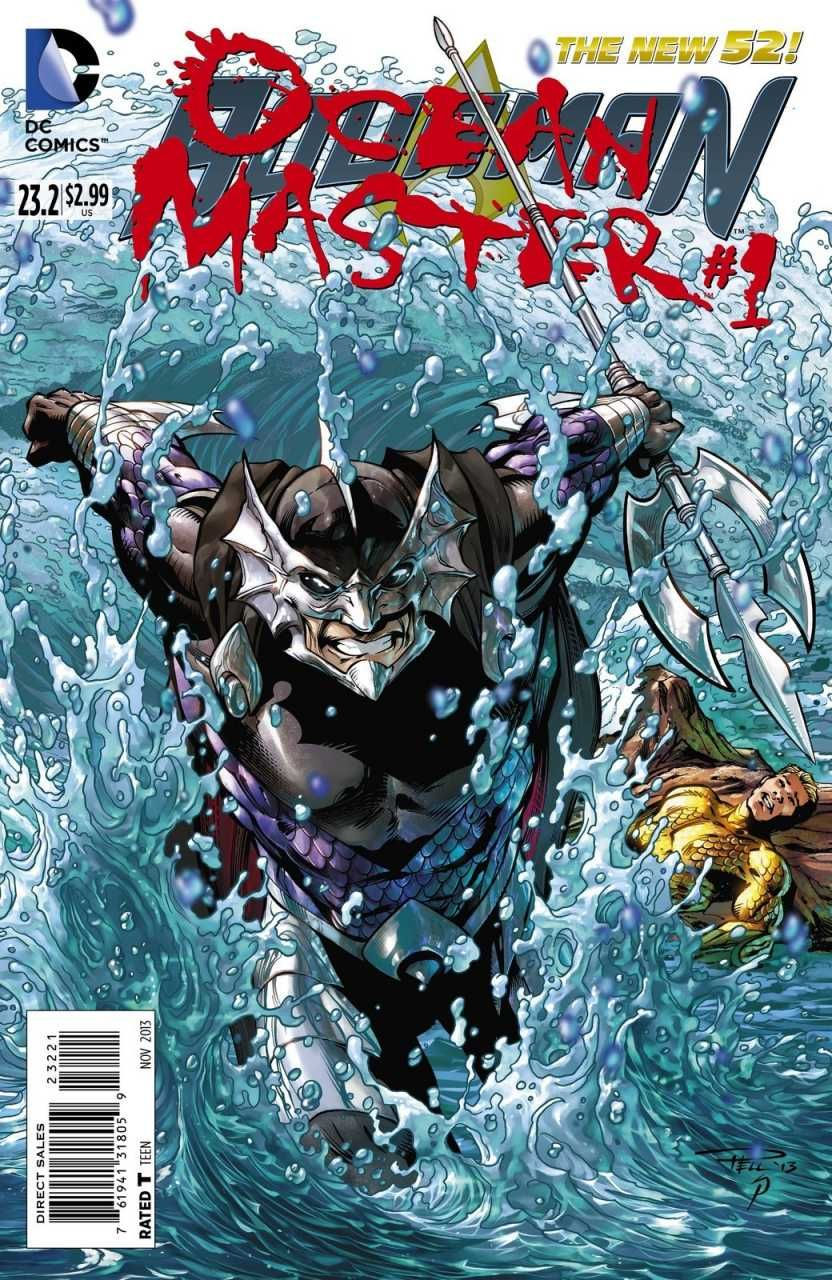
So this ties more into the plot in the Aquaman books at the time than Forever Evil. During the Justice Leaue/Aquaman storyline Throne of Atlantis, Ocean-Master had attacked Boston, League defeated ended up in Belle Reve. This was written by Geoff Johns, the man who was writing the main event and the Aquaman books. This is an actually good comic, we Orm, Aquaman's evil brother, a man who hated Humans actually being sympathetic to humans. He even saves a woman and her child from inmates. Pretty compelling stuff. Making a one-note into an anti-villain.
Count Vertigo: Green Arrow

This didn't tie-in into the main Forever Evil storyline, but it tied into Jeff Lemire's run on Green Arrow. For the uninitiated reading this Count Vertigo is Green Arrow's closet answer to the Joker. Except those two characters have different motifs (in spite of the Arrow show says). The comic shows his life as the former Count had to flee to Vancouver and what his life is like as a child, but intersected with him as an adult taking care of his mother. They also changed his name from Werner Vertigo to Werner Zylte. We also have the then-main artist of the Green Arrow book, Andrea Sorrentino on art duty and his art style makes it look very creepy, especially his Vertigo design.
Riddler: Batman

This was a fun little issue, it shows off Riddler's intelligence and intuition as he goes after a security guard who used to bully him back at Arkham Asylum. Didn't go into his origin but Scott Snyder's Batman storyline Zero Year was going to delve into that. Secret Society: Justice League

I only got this comic because it gives me more details on the storyline, which is a tenant of tie-ins. This comic is told from the perspective of the Outsider, evil Alfred to Owlman, the evil Batman, talking about his old Earth and what drives Owlman. The art looks likes nice, the limited style is great especially with the shadows. The comic us great for giving out Owlman's motivations and what Earth-3 was like and what happened to that.
Justice League: Forever Heroes

During Forever Evil, we had the Justice League out of commission, so in there books they were running at the time, they had different storylines. Justice League of America told us what happened to the out-of-commission League. They were stuck inside the Firestorm Matrix which was making them face their respective fears. Justice League Dark had Blight where the magical team had their own adventure with John Constantine assembling a ragtag team of magical users to stop the evil magic users and save Zatanna. In the main Justice League book: World building. The first bulk of the tie-ins were origins for the members of the Crime Syndicate. The Ultraman origin is great showing how backwards Earth-3 was. We see what E3 Jor-El and the Kents were like. The Owlman one showed how different what Owlman is like to Batman. Why he has sidekicks. The rest of the Syndicate origins were just shotgunned out. These issues were great at showing what Earth-3 was like and how it's different from the main universe, very cool alternate universe fiction.
The rest of the Justice League tie-ins was Cyborg trying to stop the Crime Syndicate by teaming up with the Metal Men. Very fun storyline, I like the designs of the Metal Men, Ivan Reis does great artwork here.
Future's End Month

So this wasn't an event but in 2014 DC went through weekly series mania. For Batman's 75th Anniversary they had Batman Eternal and two other series that were supposed to lead into the big event for 2015. Earth-2: World's End which I didn't read and Future's End which I only read a few issues, but I was keeping up when it was coming up. The premise is good, Terminator meets Batman Beyond, but that got lost in a sea of interconnected storylines that seem unrelated but I think could've worked in their own books. We had a team up with Earth-Prime and Earth-2 against Darkseid, Grifter (a WildStorm character) forced to work with the government, Firestorm having performance issues and guilt from not saving Green Arrow and Frankenstein, Amethyst: Princess of Gemworld, Hawkman and the Atom fight Brainiac and forming a new StormWatch. But the covers look good, very eye catching.
So in the vein of Villains Month and because at the time DC liked to make everything running series tie into and crossover, they made Future's End book. Showing all the then-currently running comics at the time five years into the future. Some were related to the main weekly series, but some were interesting what-if stories. Here are some of the issues I picked up at the time.
Supergirl
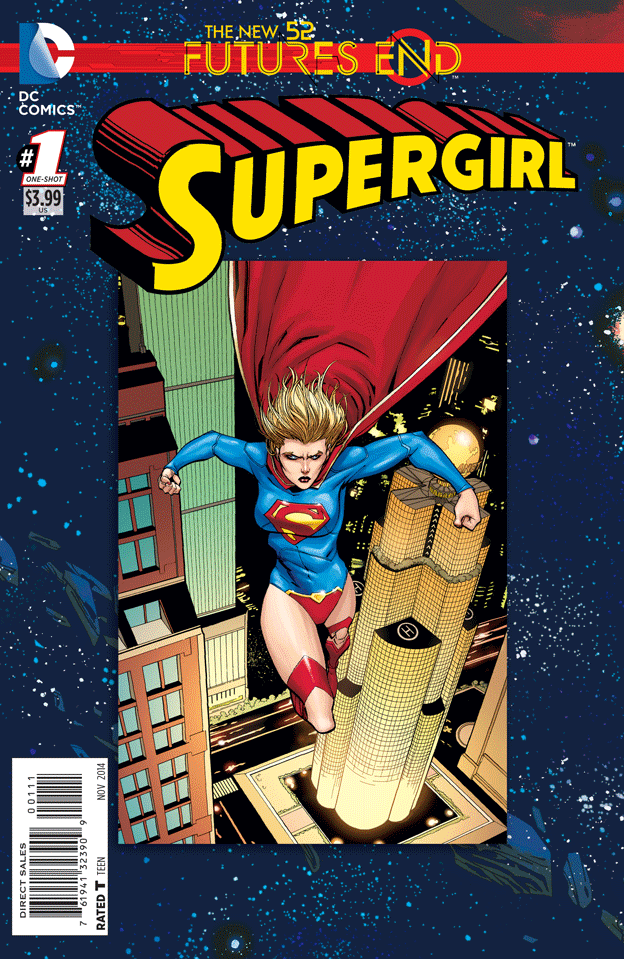
As mentioned in the villains month section Cyborg Superman was Zor-El, Supergirl's dad, not Hank Henshaw. In this possible future we see Supergirl become a cyborg. The premise is interesting, father and daughter going round killing people. The only thing I was lost about some of the side characters appeared and saved Supergirl. I was a bit confused because I only picked up a few issues, so I was lost, but it was an adequate issue.
Detective Comics
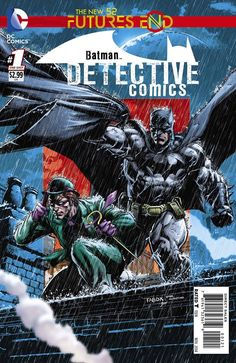
This issue gave us a glimpse at what Batman might be like in the main series. It's a interesting version, but I'll elaborate in the Batman one-shot. But this is a fun issue. The main plot is that Calendar Man is organizing a riot at Arkham Island so Batman has to team-up with the Riddler. This is a fun issue with a cool twist at the end. The art is beautiful as well. Francis Manupal has a very unique style. Very geometrical.
Grayson

So at the time Nightwing's identity was outed during Forever Evil so he became a spy for the organization Spyral. While he would go back to Nightwing, but this is an interesting what if he stayed a spy and it's a solid issue.
Written by Tim Seeley and Tom King, this issue storytelling device is like that Seinfeld episode "The Betrayal", the backwards one. It shows him being executed and the events leading up to it and like that Seinfeld it goes far in the past. His time as Nightwing and Robin and even to that eventful day at the circus.
Star-Spangled War Stories: G.I. Zombie
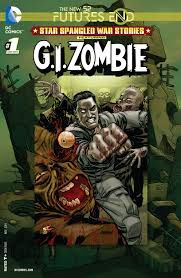
This was a short lived series written by Jimmy Palmiotti about a zombie marine. It lasted 8 issues. It served as an epilogue to the series. That's all I have to say. Only read 3 issues. Moving on.
Batman

This tied into two things. The main Future's End series and the Scott Snyder Batman run. This gave us a good look at what future Batman no. 56, his suit is more armoured and uses more technology based on the Justice League and it tied into Batman trying to clone himself to make secure his legacy. It's serves both storylines. The suit looks good. Art looks nice. ACO is a great comic book artist. Green Arrow

This one tied into the overall Future's End storyline. See in Future's End Green Arrow faked his death so he can rescue some Earth-2 refugees from Cadmus Island, a black site prison ran by King Faraday and Project Cadmus which is the same place as Grifter and the Earth-2 version Lana Lang is located. (See what I mean by too many plot threads.) This also tied into the Jeff Lemire run on Green Arrow, we have characters like Oliver Queen's half-sister Emiko and also the Outsiders, a group of weapon themed warrirors based out of the island where Oliver Queen washed up. This is basically an epilogue to Lemire's run. Good story.
Teen Titans

Another plotline in Future's End was Tim Drake, struggling with civilian life after the Teen Titans were killed in the Earth Wars. This story doesn't go into detail, but it's actually about a new version of Titans made up of Earth-2 heores and a few one-shot characters. The Earth-2 heroes were Klarion the Witch Boy, Lagoon Boy and Kid Flash and the one-shot characters were Heretic, a clone of Damian Wayne from Batman, Inc. and a girl named Animal Girl. The book is fine, a bit dark in some places, but the team roster is different and unique. I like the character designs of the Titans. They look cool. Catwoman
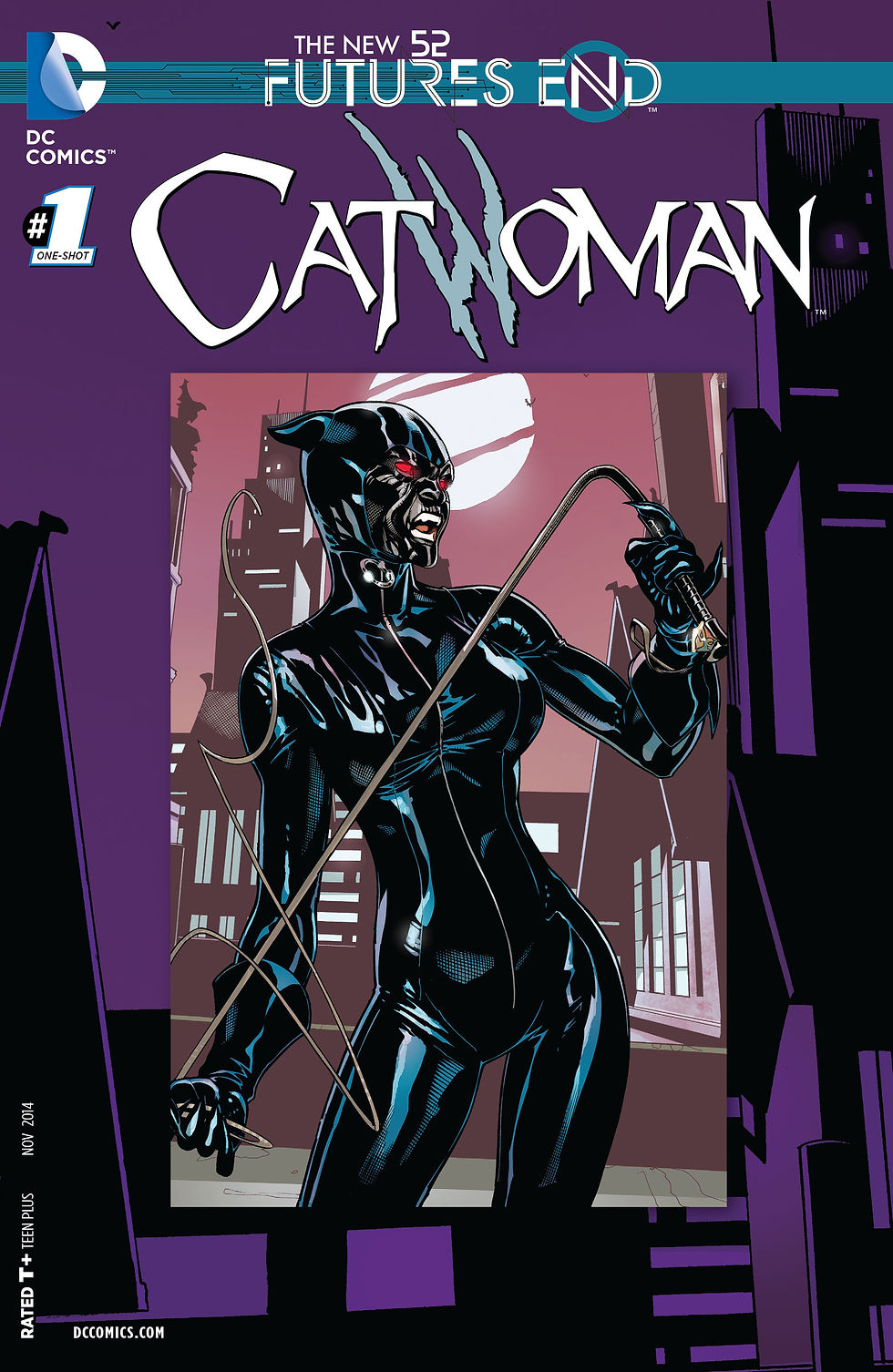
At this point in DC circulation, the weekly series Batman Eternal was running to celebrate the 75th Anniversary of the Dark Knight. This maxiseries had a big effect on the Bat books, Jim Gordon wasn't Police Commissioner anymore and replaced by Maggie Sawyer, Stephanie Brown the Spoiler came back, Harper Row became Batman's new sidekick Bluebird and Catwoman moved onto being the lady thief and she became Gotham City's most powerful crime boss, taking from her father Rex "The Lion" Calabrese. This story kinda acts like a cap off to this period of Catwoman's life. Even though Selina Kyle went back to being Catwoman in a short time before DC Rebirth so rendering this comic meaningless in the long run. Still a good story. Another thing to add is that cover lied. Birds of Prey

This one is a little bit of a mess. The story is Black Canary becomes leader of the League of Assassins. She's saving kids, she fights the future version of Batgirl, Bette Noir, yeah. It could work as Canary and Babs were allies and now are enemies, but is never touched upon. A mess. The Flash

Another unrelated story, but ties into what was happening in the main Flash book at the time. So at this point they brought Wally West, Kid Flash, back into continuity but it was revealed that he was another person named Wally West but is still related because they share a Grandpa. The plot is the Future Flash just stopped Reverse-Flash (Iris West's brother, not Eobard Thawne from TV) from killing Wally, by killing him. It's revealed Future Flash is actually Barry Allen from the twenty years from the future trying to save Wally and Iris. Normal Barry is killed so Future Barry tries to do this again. (Time travel stories are very hard to explain.) But this one-shot ends with a cliffhanger with Wally taking the mantle of the Flash and taking on Future Flash. Now I would like to write about Wally's costume. I like it. The silver makes it different from, the red highlights are a great match for the silver. Brett Booth is one of those hit or miss artists for me. Usually his art stye looks great, very exaggerated and a little cartoony but with a very Jim Lee vibe But some of his character are a little thin. This was an alright book. Justice League and Justice League United


Now some of these one-shot issues were two parters that started in one book and concluded in a related book. They had an Aquaman one starting in his solo series and then ended in his short lived team book Aquaman and the Others. The first part of this Jeff Lemire written two parter was in his League book Justice League United. His team book was about a League that dealt with more cosmic forces. This storyline deals with both teams dealing with a jailbreak on Mars. (It's the future.) The team set up in the book is pretty is pretty cool and different. The League in the future includes Equinox, a Cree hero with elemental powers, Animal Man, pretty much self-explanatory, Vostok-X, a Russian cosmonaut who hung out with Aquaman, Stormguard, a guy who saved the President and Dawnstar and Wildfire, two members of the Legion of Superheroes. Also Flash and Cyborg of the old League are here. The best bit was the prison scenes, because it's a Where's Wally of DC supervillains. The Mars prison is a fun premise. The second part, the Justice League one-shot does falter in the end with Captain Atom, but all in all it's a cool story.
Booster Gold

Now Booster Gold is a character who is tied with the future of the DC universe, so you'd expect the time traveler would be involved in Future's End. Well this is less of a tie-in and more of a prologue to something else. The premise is Booster Gold is bouncing round different eras, Victorian London, the far flung future of Kamandi: Last Boy on Earth and the main DC universe warning his younger self about Superman and Wonder Woman's relationship. But after awhile, he isn't bouncing through different eras, but different cities. He ends up in Hub City and sees Blue Beetle, Ted Kord, fight Captain Atom, a captin who looks like the original Charlton Comics version. He's later transported away to some ab where a mechanical voice has his sister captured and forces him to surrender. This comic has a great sense of foreboding. But what is it foreboding to? The next event of course Convergence

So one of the most famous event comics are DC's Crisis. The event were made to ake continuity more cleaner by rebooting the universe, like a computer. Convergence was an event that was supposed to harken back to those style of events by giving us the answer "Where do world's go when they die?" and in 2015 DC answered this vague question. The main storyline is that Brainiac has been collecting cities from various universes, timelines and continuities for his collection. But when he goes missing, his servant Telos takes control, letting each city fight out for a chance for freedom. The event itself is good, not great or as memorable, but still has it's merits. It's mostly an Earth-2 story so it didn't do anything universe changing. It was the tie-ins that people liked the most.
These two part stories focused on a different version of different characters throughout DC's history. They made a murder's row of writers working on thee tie-ins; Gail Simone, Greg Rucka, Dan Jurgens, Dan Abnett, Marv Wolfman and Len Wein. DC even were putting more effort in pushing the tie-ins than the main event. Just look at this trailer.
These two parters were divided up into four sections, Pre-Flashpoint (the 2000's), Pre-Zero Hour (the 1990's), Crisis on Infinite Earths (the 1980's) and Pre-Crisis on Infinite Earths (everything else pre-1985). So let's dive into these acclaimed tie-ins. Pre-Flashpoint The Atom

So before the New 52, Ray Palmer was a bit angry over the fact that his successor Ryan Choi was killed by Deathstroke and that's how we got the "Welcome to Pain!" meme. This story is about a slight mad Atom finding redemption, while fighting Barracuda from the Extremist Universe. The story itself is good, Ray Palmer looking for redemption is pretty cool which the writing does it justice. Batgirl

Barbara Gordon was Oracle before the New 52, so the mantle was handed down to several people and she got her won tie-in with Nightwing with Nightwing, which I didn't read. The then-current Batgirl at the time was Stephanie Brown, a young woman whose father was a supervillain, but she became the hero Spoiler to spoil his crimes and then she became Batgirl. She has a friendship with Cassandra Cain and a relationship with Tim Drake the third Robin. This comic is more of a romance story twined with a superhero story, with Stephanie and Tim working out their problems while helping the Flashpoint Catman stop Flashpoint Gorilla Grodd. It's a fun read.
The Question

During the 52 weekly series, Vic Sage, the Question died from cancer. He made his successor was Renee Montoya, a former GCPD cop who was left the force after being framed for murder by Two-Face and was ostracised by her family because Two-Face outed her as a lesbian. The plot of this tie-in is that Montoya, Batwoman, who was her ex and Huntress to look for Two-Face whose trying to find a better version of Harvey Dent. This story is great, written by Greg Rucka, this story is a love letter to Montoya, while I haven't read about her in the comics, I do know about her history as a character. The scenes with her family are gold, especially when her father accepted her. This is honestly great. Superman

So at the time Superman comics weren't doing so good during the New 52. I only read a few issues and some of the Supergirl stuff. So this comic, written by Dan "I Killed Superman" Jurgens is more of a reminder of the classic Superman. The pre-Flashpoint Superman. This story is about the Man of Steel protecting Lois Lane while she gives birth to their son, Jonathan. I've only read the first part of this comic so I can't review it as a whole, but this comic did some major effects. Firstly, it put to rest those debate wherever Superman can have a child and secondly it was the birth of Jonathan Kent, the Superboy. After Convergence OG-Superman came to Earth and then became the modern Superman, with Superboy being a new addition to the Superman mythos. Pre-Zero Hour
Justice League International

Justice League International was a team made up of heroes from around the world. The book was known for it's more light hearted and comedic tone. In this story the League is made up of some of it's original lineup (Blue Beetle [Ted Kord], Captain Atom, Fire, Ice and Martian Manhunter), sans Batman and Booster Gold because they had their own tie-ins. The story here is Ted Kord leading the team against the Kingdom Come version of Wonder Woman and other background characters from the Mark Waid story. The main crux of the drama is Ted Kord trying to manage the team, while missing his good friend Booster Gold. Another good thing is seeing the Justice League International, one of DC's most light hearted series go up against the characters from Kingdom Come; DC's commentary on the darker and edgier characters of the nineties. This is a good comic. The covers look great as well, especially the second one.
Suicide Squad

This comic is more of a love letter to old school type of Suicide Squad stories. The story here is that Amanda Waller has set up the Suicide Squad, one of the earliest comic book series to go down a darker path, up against characters from Kingdom Come, DC's previously mentioned commentary of 90's anti heroes. Very interesting concept. The lineup of Task Force X is also cool we have villains like Bane, Black Manta, Poison Ivy, Bronze Tiger, Captain Boomerang, Count Vertigo, Cyborg Superman, Deadshot, Deathstroke and Star Sapphire. This is a cool story with lots of twists and turns so I won't spoil them for you.
Crisis on Infinite Earths New Teen Titans

One of the return writers coming back to write the tie-ins was Marv Wolfman, the man who wrote some of the most famous Teen Titans storylines, like the Judas Contract. The main story here is that the Teen Titans (consisting of Nightwing, Wonder Girl, Beast Boy, Cyborg, Starfire, Jericho and Kole) dealing with being cut off from their world as the Wolfman run was akin to a soap opera than a superhero story. We see the Titans fight the Tangent version of the Doom Patrol. Wolfman doesn't make the Tangent Universe Doom Patrol evil as well, showing comparisons between the teams. This a fun comic.
Pre-Crisis on Infinite Earths So while the previous tie-ins were set in a specific era of the DC universe, the Pre-Crisis weeks actually offered us a bit of variety because Crisis on Infinite Earth was DC's first continuity reboot so each comic during the week was different. Some focus on the Golden Age version characters, others were about characters from other universes. This is my favourite of the tie-ins as they showed different versions of familiar characters. Action Comics

The match-up is interesting; we have the original Golden Superman and Power Girl up against the Soviet Union Wonder Woman from Mark Millar's Superman: Red Son. So one of the icons of 1940's America up against the Communist version, a very interesting match up indeed and Power Girl's struggle living without her powers in a very good piece of writing on behalf of the writer, Justin Gray. I also like how they resolved the conflict by talking. Very Superman.
Two thing I will criticise is that continuity on the Red Son front. We have a bald Lex Luthor talking with Joseph Stalin. Lex Luthor was bald years after Stalin died and they made Luthor a villain, which in the original Red Son there was no outright villain. The art is a bit iffy, mostly with weird proportions and faces.
World's Finest Comics

Now is a very bittersweet comic. This is about the Seven Soldiers of Victory, a superhero team made up of, you've guessed it, seven heroes: Crimson Avenger, Shining Knight, Star-Spangled Kid, Stripsey, Vigilante, Green Arrow and his sidekick Speedy. This comic has three members die in the first issue. Green Arrow and Speedy die from falling off and Stripesy dies of pneumonia, because this is a 40's comic. But the bittersweet part is when we see the Soldier's last stand against the Weaponers of Qward. This comic is a touching tribute to the works of Sheldon Mayer, the creator of DC's more funny characters and worked during DC's early days.
I also liked the character of Scribbly, I think DC should bring him back. Plastic Man and the Freedom Fighters

Another thing to known about the history of DC comics is they like to buy smaller publishers. Characters like Captain Marvel, Blue Beetle and Plastic Man were all published by Fawcett Comics, Charlton Comics and Quality Comics respectively. This is about Plastic Man and the Freedom Fighters of Earth-X and what happened to them. We learn that due to the domes power dampeners the Freedom Fighters have been captured by the Nazis (Earth-X is the obligatory Axis-Win-World-War-II universe.) But when the dome falls they team up with the Nazis to fight cyborgs from the Future's End storyline. (Comic books, am I right!) This comic is a little bit dyer for a Plastic Man story, but the second part does bring in moments of levity. The artwork is fits Plastic Man, he gets his stretchiness well and does great with exaggerations. This is a fun little comic, if a bit dyer. Blue Beetle
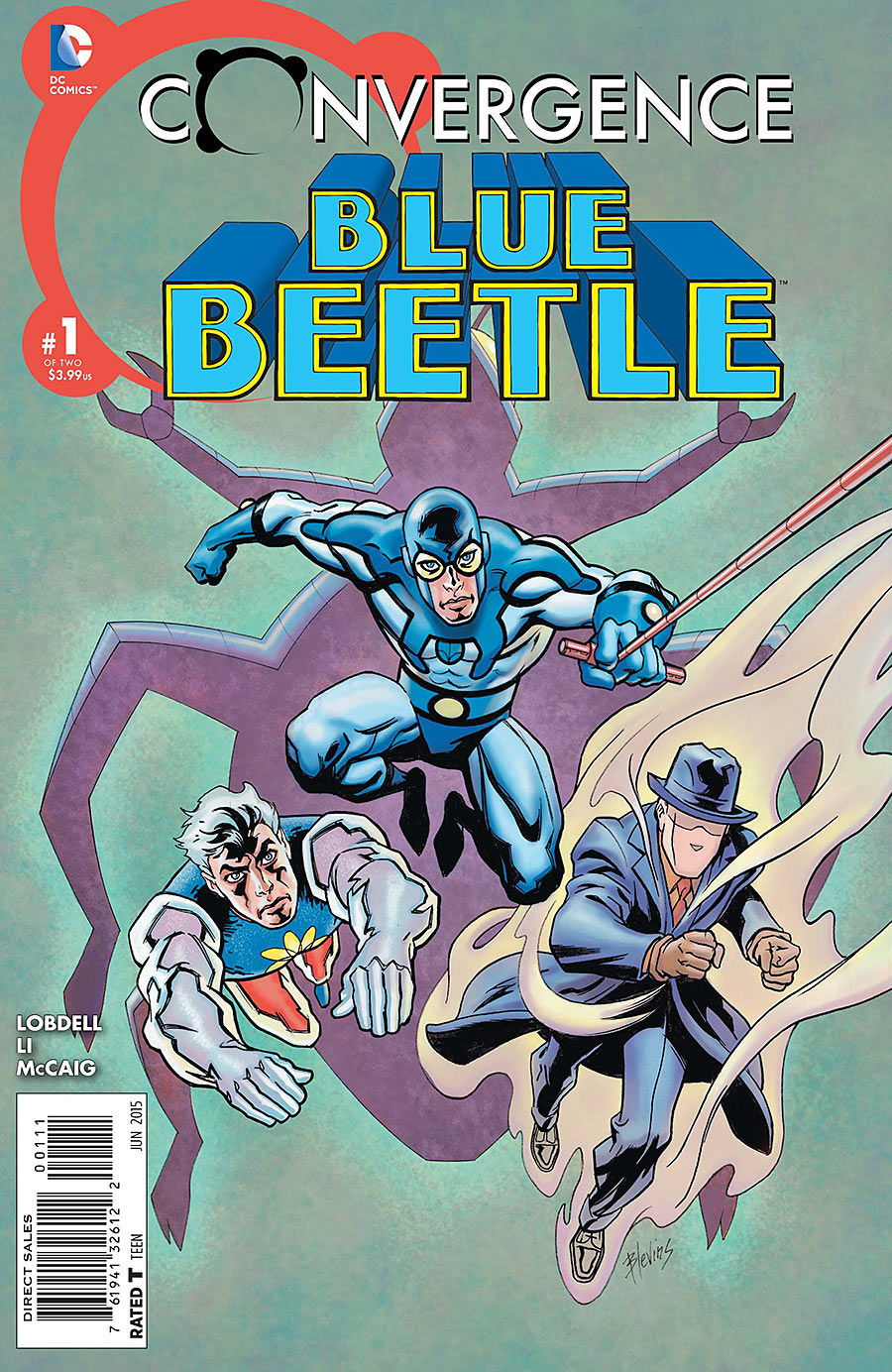
Set in the Charlton Comics universe, this one is less of a Blue Beetle story and more of a Charlton Comics story. This the Ted Kord version of Blue Beetle, Captain Atom and the Question facing off against the Legion of Superheroes. The story is good, it was written by Scott Lobdell, a controversial writer but his does a fine job here. He does some cool stuff with character dynamics. The art is also great Yishan Li does great, everything looks fluid. I hope she gets more work at the big two.
Shazam!
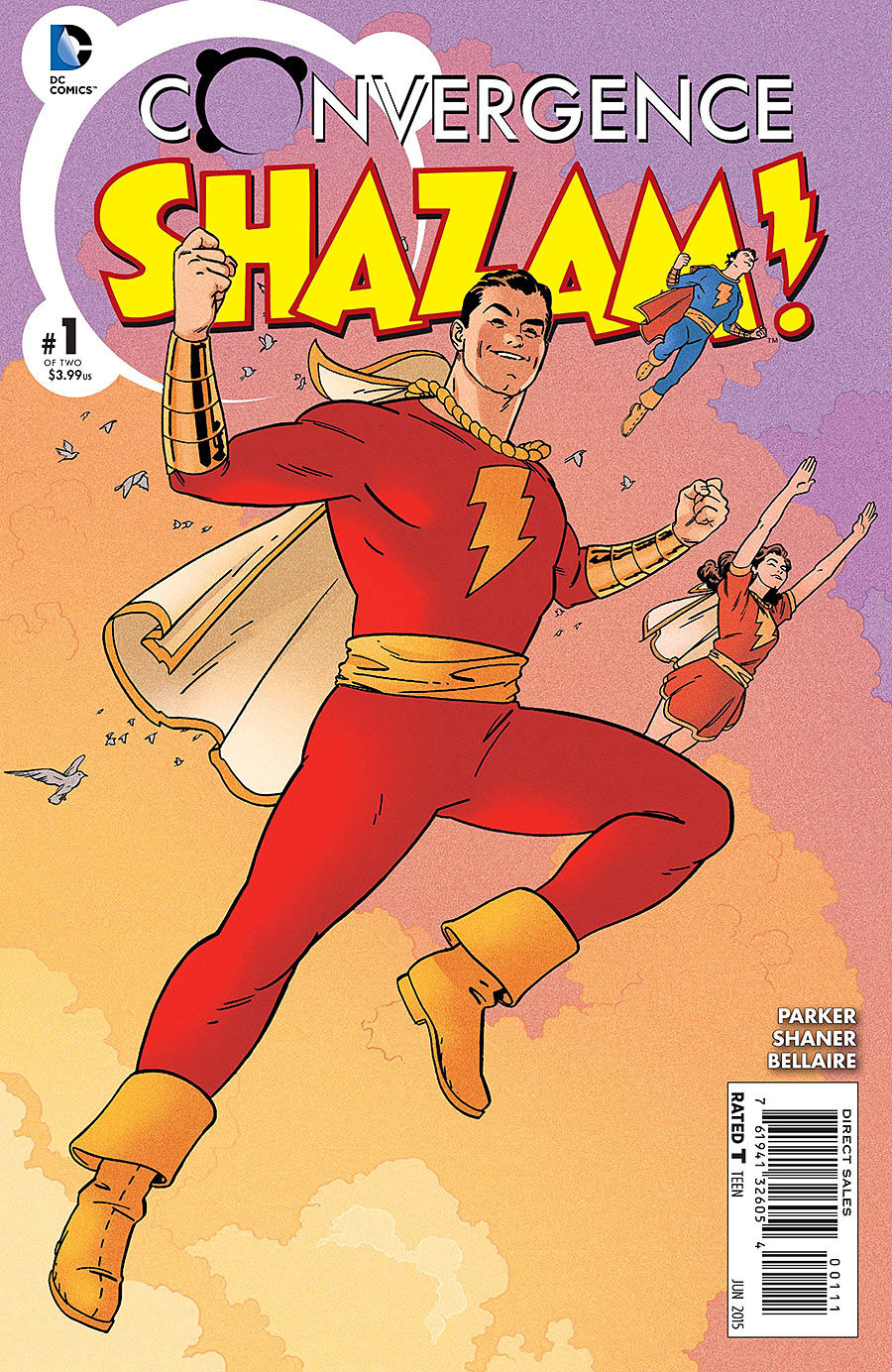
Another two parter where I only read the first issue. This is very fun. I got a very Sunday paper vibe from this comic. The art looks beautiful, Doc Shaner does art duties and he really captures the feel of an old Golden Age comic but still feels very modern. He makes the characters all match up to what they looked like in the 40's. Crime Syndicate
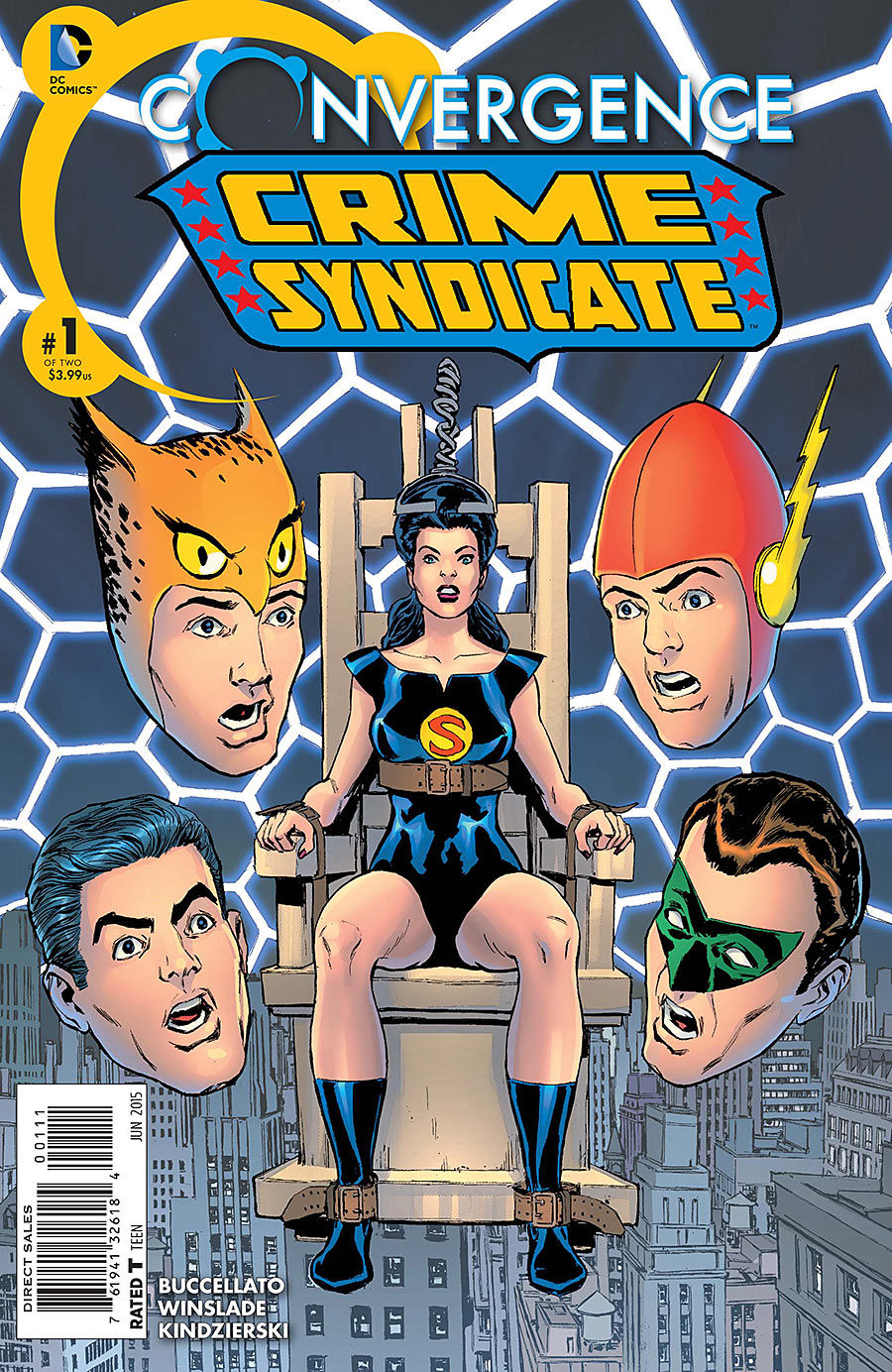
Now this is an interesting comic. The main premise is that were focusing on the Crime Syndicate, the evil Justice League, coming to break out Superwoman, the evil Wonder Woman, from prison. But they end up fighting the Justice League from Grant Morrison's DC One Million series. A good thing about this comic is Superwoman's inner monologue. We have her thinking about her life and having regrets. Very good character piece. Booster Gold

So to end this section let's finish this by focusing on Booster Gold. When we left Booster, he was captured by Brainiac to save his sister. Brainiac's gone now so it's a fun odyssey throughout all the different cities. This comic actually ties-into the main events of Convergence. This is a fun ride, full of surprises.
So those were all the tie-in comics to DC's related events. If you want go check them out. This is not an endorsement, if you want to check them out then do it. There all collecting in trade. Now wait for me to publish part of this guide when I talk about Marvel.





Comments